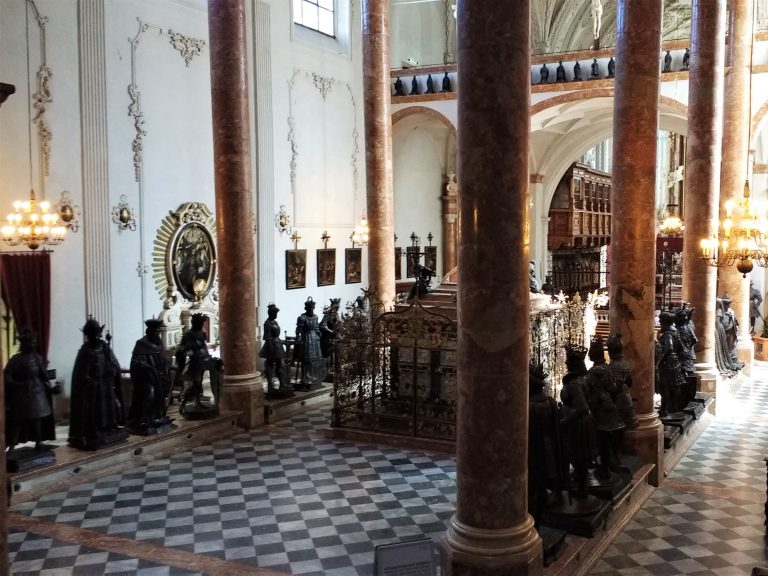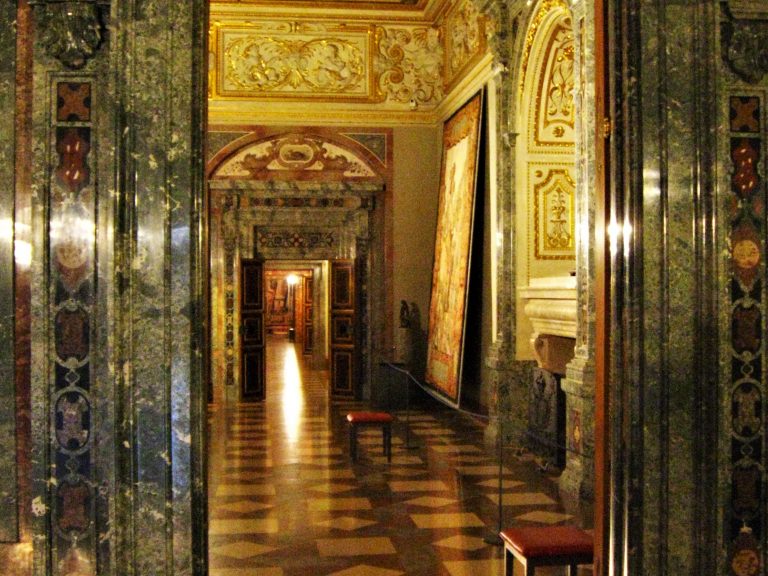Chapter 9. Bavaria and the Munich Residence 1550-1650
Germany at the end of the sixteenth century was made up of a bewildering assortment of sovereign states, prince bishoprics and imperial free towns and cities. They all owed nominal allegiance to the Holy Roman Emperor, who was chosen by seven princely Electors, four of them secular and three ecclesiastical. Since 1452 the position had been held by the Habsburgs, Europe’s pre-eminent family, who were also hereditary rulers in Austria, Hungary, Bohemia and parts of northern Italy; a separate branch ruled Spain, the Netherlands, Naples and, through its overseas conquests, parts of Asia and the New World. Charles V (r. 1519-1556) ruled over the first empire on which, so it was said, the sun never set.
Bavaria in southern Germany was one of the largest states in the Holy Roman Empire. It had been governed by the Wittelsbachs since the twelfth century. Fiercely Catholic, and loyal to the Emperor as long as he maintained his distance, the Dukes of Bavaria also had strong dynastic instincts; they looked back to the first half of the fourteenth century, when their own ancestor, Louis IV the Bavarian, had reigned as Emperor (r. 1328-1347).
During the Middle Ages Wittelsbach disputes over inheritance had resulted in repeated territorial divisions. In 1506 Bavaria was finally united under one branch of the family; Munich became its capital and the Munich Residence its permanent seat of government. Although not as large as the Imperial Free city of Augsburg, Munich had geographical as well as political significance. It stood at a cross-roads for those travelling from northern and central Europe to Italy in the south, and from Vienna and the Habsburg lands in the east to France and Spain in the west. It received regular visits from the royal elites of Europe, sometimes in person, sometimes through their representatives and ambassadors. Such visits added greatly to the Wittelsbachs’ prestige, but they imposed considerable demands on the court and its buildings.
From the mid-1500s the Dukes of Bavaria embarked on several ambitious building schemes that were designed to modernise the Munich Residence and turn it into the largest palace complex in Germany. To a great extent they succeeded; writing in 1644 after the main period of building was complete, the Italian court musician, Baldassare Pistorini, stated that the Residence was:
‘a sumptuous palace, an imperial [my italics] rather than a ducal residence……In a corner of the electoral city of Munich there is situated another [city] more delightful and more beautiful. If others have called the city a large palace, I will call this palace (it being the largest, richest and noblest that can be seen, found or imagined) a little city, because of the amplitude of its site, its majesty and grandeur, and no less because of its marvellous structure’.
Scagliola, with its uncanny resemblance to real marble, played a major role in the decoration and furnishing of this ‘sumptuous palace’.
References:
Baldassare Pistorini quotation from S.J. Klingensmith, The Utility of Splendor Chicago and London 1993 p. 35. Pistorini wrote a detailed description of the Munich Residence. Although at the time he was working in the service of the Bavarian Elector, Klingensmith believed that his comments were sincere and went beyond mere flattery.
Alastair Laing: Part IV Central and Eastern Europe in Baroque and Rococo, Architecture and Decoration ed. Anthony Blunt, Ware 1988 pp.167-176

The memorial cenotaph of Holy Roman Emperor Maximilian I (r. 1459-1519), flanked by 28 over-size bronze sculptures of illustrious individuals with Habsburg connections (monument completed 1584). Hofkirche Innsbruck.

The Grottenhof (Grotto Courtyard), built for Duke Wilhelm V in the 1580s. The late Renaissance design by Friedrich Sustris is full of symbolism, centred around Hubert Gerhard’s bronze statue of Perseus slaying the Medusa.*

The Steinzimmer (Stone Rooms) – detail. The richly decorated suite of rooms, designed by Hans Krumper, the son-in-law of Friedrich Sustris, was commissioned in 1611 by Duke Maximilian I and intended solely for the purpose of accommodating Imperial visits. The door casements, chimney surrounds and wall mouldings are all made from scagliola.*
* © Bayerische Schlösserverwaltung, www.schloesser.bayern.de
Photos by Richard Feroze,
Chapter 9. Bavaria and the Munich Residence 1550-1650
Germany at the end of the sixteenth century was made up of a bewildering assortment of sovereign states, prince bishoprics and imperial free towns and cities. They all owed nominal allegiance to the Holy Roman Emperor, who was chosen by seven princely Electors, four of them secular and three ecclesiastical. Since 1452 the position had been held by the Habsburgs, Europe’s pre-eminent family, who were also hereditary rulers in Austria, Hungary, Bohemia and parts of northern Italy; a separate branch ruled Spain, the Netherlands, Naples and, through its overseas conquests, parts of Asia and the New World. Charles V (r. 1519-1556) ruled over the first empire on which, so it it was said, the sun never set.

The memorial cenotaph of Holy Roman Emperor Maximilian I (r. 1459-1519), flanked by 28 over-size bronze sculptures of illustrious individuals with Habsburg connections (monument completed 1584). Hofkirche Innsbruck
Bavaria in southern Germany was one of the largest states in the Holy Roman Empire. It had been governed by the Wittelsbachs since the twelfth century. Fiercely Catholic, and loyal to the Emperor as long as he maintained his distance, the Dukes of Bavaria also had strong dynastic instincts; they looked back to the first half of the fourteenth century, when their own ancestor, Louis IV the Bavarian, had reigned as Emperor (r. 1328-1347).
During the Middle Ages Wittelsbach disputes over inheritance had resulted in repeated territorial divisions. In 1506 Bavaria was finally united under one branch of the family; Munich became its capital and the Munich Residence its permanent seat of government. Although not as large as the Imperial Free city of Augsburg, Munich had geographical as well as political significance. It stood at a cross-roads for those travelling from northern and central Europe to Italy in the south, and from Vienna and the Habsburg lands in the east to France and Spain in the west. It received regular visits from the royal elites of Europe, sometimes in person, sometimes through their representatives and ambassadors. Such visits added greatly to the Wittelsbachs’ prestige, but they imposed considerable demands on the court and its buildings.
From the mid-1500s the Dukes of Bavaria embarked on several ambitious building schemes that were designed to modernise the Munich Residence and turn it into the largest palace complex in Germany. To a great extent they succeeded; writing in 1644 after the main period of building was complete, the Italian court musician, Baldassare Pistorini, stated that the Residence was:
‘a sumptuous palace, an imperial [my italics] rather than a ducal residence……In a corner of the electoral city of Munich there is situated another [city] more delightful and more beautiful. If others have called the city a large palace, I will call this palace (it being the largest, richest and noblest that can be seen, found or imagined) a little city, because of the amplitude of its site, its majesty and grandeur, and no less because of its marvellous structure’.

The Grottenhof (Grotto Courtyard), built for Duke Wilhelm V in the 1580s. The late Renaissance design by Friedrich Sustris is full of symbolism, centred around Hubert Gerhard’s bronze statue of Perseus slaying the Medusa.*
Scagliola, with its uncanny resemblance to real marble, played a major role in the decoration and furnishing of this ‘sumptuous palace’.

The Steinzimmer (Stone Rooms) – detail. The richly decorated suite of rooms, designed by Hans Krumper, the son-in-law of Friedrich Sustris, was commissioned in 1611 by Duke Maximilian I and intended solely for the purpose of accommodating Imperial visits. The work has been reinstated on two separate occasions: the first following a serious fire in 1674, and the second in the 1960s during the post-war reconstruction of the Munich Residence. Most of the internal architecture is made from scagliola.*
References:
Baldassare Pistorini quotation from S.J. Klingensmith, The Utility of Splendor Chicago and London 1993 p. 35. Pistorini wrote a detailed description of the Munich Residence. Although at the time he was working in the service of the Bavarian Elector, Klingensmith believed that his comments were sincere and went beyond mere flattery.
Alastair Laing: Part IV Central and Eastern Europe in Baroque and Rococo, Architecture and Decoration ed. Anthony Blunt, Ware 1988 pp.167-176
* © Bayerische Schlösserverwaltung, www.schloesser.bayern.de
Photos by Richard Feroze,

